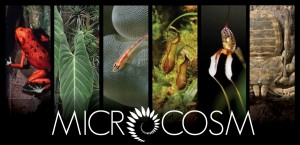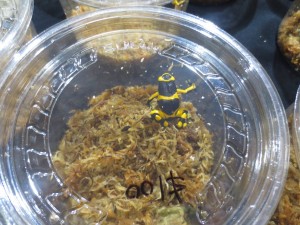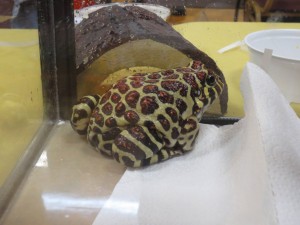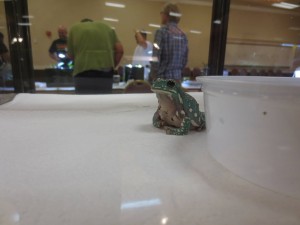You never know what you got till it’s gone. Although you think I might be referring to a significant other, best friend, or family member, I’m actually referring to the most important thing for many college students: a day off, of which we have exactly one of this semester when you exclude spring break. If you thought people were indecisive about choosing majors, you should see the flurry of conversations that go on when students try to decide on what to do with this precious little free time. Should one just sleep the entire day? Embark on an epic three-day outing to the great outdoors? Catch up on all of the work that you’ve gotten behind on? Day trip to L.A.? Pull an all-night marathon of Game of Thrones in anticipation of Season 4? The possibilities are endless.
Personally, I just wanted to sleep all day, but I felt that I should be more productive, so I did the obvious thing: I went to a reptile show. I’m sure that’s exactly what you were thinking.
Most people don’t even know that reptile shows exist. But in fact they do, and tens of thousands of people flock to some of the larger ones in SoCal, like the Reptile Super Show (Pomona, San Diego) or the North American Reptile Breeders Conference (Anaheim). For anyone looking to take their kid somewhere for the day, I highly endorse reptile shows; they’ll have better stuff than any zoo in the world, and better yet, you can buy it!

Most of the large shows are during the summer to maximize attendance, but there are many smaller ones throughout the year that feature equally interesting animals. So after spending the Friday off doing all of my homework for the weekend, my dad picked me up from Pomona and we drove to San Diego for Microcosm, a show with a focus on amphibian conservation (for those who don’t know, amphibians are one of the most at-risk groups on the planet due to disease and habitat loss).
So what’s a reptile show like? Usually the way I describe it is that you see a lot of things you see on National Geographic. The majestic red-eyed tree frog? Yours for $19.99 at most shows. Poison dart frogs? Totally legal and yours for anywhere from $40 to $400. Any of the colorful chameleons? $50 and up.

This show especially focused on dart frogs, not something I’m personally familiar with (I specialize more in geckos and salamanders), but seeing these little hopping balls of color is one of the more amazing things at every show, and the fact that they’re all 100% legal (in captivity, they lose their poison) is mind-boggling. Setting up planted tanks with a colony of Dendrobates is on my short-list of “top pet projects when I have a real job.” I was chatting with a couple vendors who had gotten the first export of a orange Phyllobates terriblis (the name says it all) in the entire world, just one of many frogs that are incredibly rare and only found at shows like this where anonymous keepers from forums, boards, and listservs appear out of the blue with their personal stock that the world’s greatest zoos can’t even get their hands on.

You don’t have to be a buyer to appreciate the impressive animals that turn up at these shows. If you don’t fancy one of the tiny frogs (it can be a pain to feed them fruit flies that get out and crawl all over your house after all), why not try something larger and more personable like the coralline frog to the left? If you’re like me, you didn’t even this frog existed up until now. In total, there are about 4,800 species of frogs, and I can probably name no more than 100 on a good day.
You might wonder what selling frogs has to do with their conservation. The reptile and amphibian community is amongst the largest in pushing for greater restrictions on the trade and export of exotic animals, a practice in many third-world countries that goes highly unregulated and that contributes to depletion of natural resources. As a result, most keepers only purchase captive-bred specimens, and they constantly spread increasing awareness about the plight of many of these animals. Despite very few science majors in the community, let alone people who actually study frogs, many people are amazingly well-versed in at least the basic science behind the animals they keep, whether that’s in how different wavelengths of visible (and invisible) light affect these animals or in the processing of macro-vitamins in different species. Furthermore, captive breeding efforts are far greater (and far more successful) than zoos or private institutions, and it may well be that endangered species could be restored using captive stock. The example that comes to mind is how major news outlets played up the disappearance of the axolotl in its natural habitat. Of course it’s a bad thing when the native range of an animal is no longer suitable for it, but many people were led to believe that the animal is now extinct, when in reality, you can buy one of the hundreds of thousands of captive specimens for as little as $10 online.

Of course, some people inevitably wonder why you would want to own a frog (or any exotic animal) in the first place. After all, they sit, eat, poop, and repeat. There may be some mating in between. They don’t respond to names or affection, will readily bite the hand that feeds them (albeit due to poor depth perception), and only make sounds when you’re trying to sleep. At the same time, they’re something different, something otherworldly, something that links you to a time when we didn’t bulldoze, deforest, pollute, and destroy. It’s a little slice of nature. It’s a reminder of the simple things in life (especially when all you have time to do is sit, eat, and poop). In their own way, each of these animals has personality and character. After all, nothing makes for a conversation starter like walking into someone’s room and coming face-to-face with a grouchy lizard.
